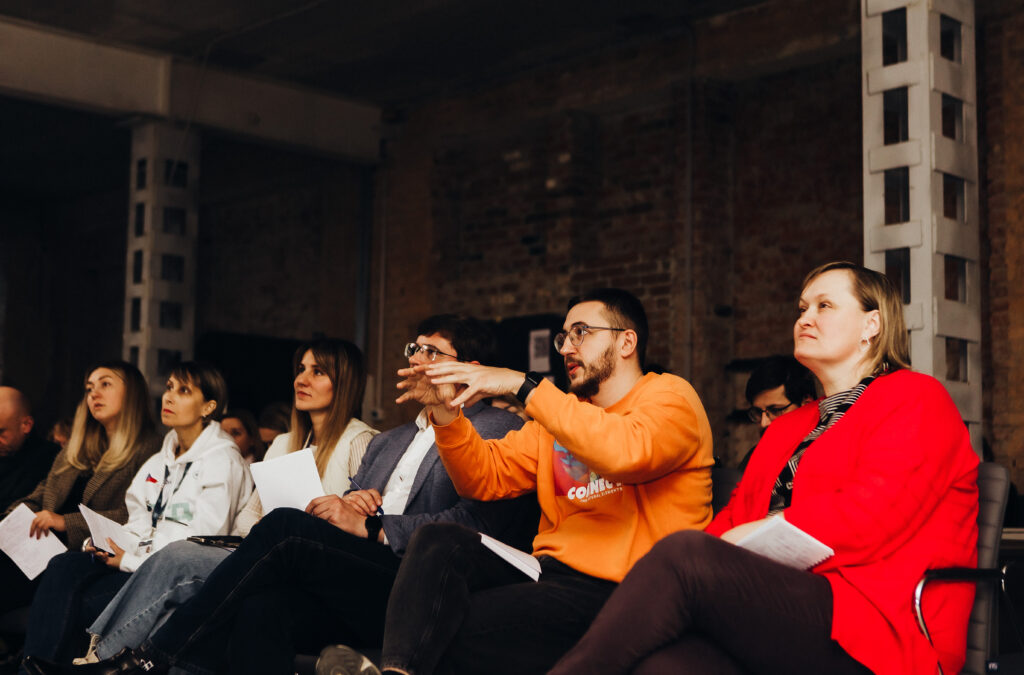LDN and Partners Will Continue Addressing Security Challenges in Ukrainian Communities In 2025
Publication date: December 27, 2024
Author: Yuliia Bilyk, Communications Manager, Legal Development Network
Throughout 2024, the Legal Development Network, with the support of the International Renaissance Foundation and the European Union, implemented the project “Sense of Security, Social Cohesion, and Dialogue Practices: Identifying Optimal Tools at the Community Level.” This initiative enabled the tracking and analysis of the most prominent factors of concern, the trialing of tools to reduce anxiety levels, and the outlining of future steps to address today’s security challenges.
Security Trends Across Three Communities
The project was implemented in the Kolomyia Community of the Ivano-Frankivsk region, the Turbiv Community of the Vinnytsia region, and the Shevchenkove Community of the Mykolaiv region, covering Western, Central, and Southern Ukraine. This distribution allowed for the observation of trends and comparisons between rear communities and a frontline, de-occupied community. In the project’s first phase, a comprehensive sociological study was conducted, revealing the level of perceived security and the factors shaping it.
«Замір безпекових проблем і потреб вдався. Війна та пов’язані з нею мобілізація, перебої з електропостачанням, економічні проблеми (безробіття, інфляція тощо) — це ті фактори, які найбільше послаблюють відчуття безпеки в усіх трьох громадах. Із одного боку, це очікувано. З іншого, ми змогли виділити певну специфіку кожної з громад. Серед факторів послаблення безпеки на другому і третьому місці у Коломийській громаді — економічні проблеми та відключення світла, у Турбівській — мобілізація та відключення світла, у Шевченківській — відключення світла та мобілізація», — розповідає залучена експертка, соціологиня Марина Шпікер, яка аналізувала дані опитування.
“Mapping security issues and needs were a success. The war, along with related factors such as mobilization, power outages, and economic difficulties (unemployment, inflation, and so forth), emerged as the primary factors weakening the sense of security across all three communities. On one hand, this is expected. On the other, we identified specific nuances unique to each community. For instance, in the Kolomyia Community, economic challenges and power outages ranked second and third. In the Turbiv Community, mobilization and power outages held same spots, while in the Shevchenkove Community, power outages and mobilization were key factors,” explains Marina Shpiker, a sociologist and expert analyzing the survey data.
In frontline and rear communities, perceptions of safety in daily life vary significantly. In the Shevchenkove Community, only 36% of respondents reported feeling safe. Meanwhile, this number rises to 62% in the Turbiv Community and 72% in the Kolomyia Community, effectively doubling the proportion of those feeling secure compared to residents of the frontline community.
“For us, it was important to participate in this survey in order to obtain reliable statistical data on security issues in the community. The interviews were conducted by local residents, who had already established trust within the population. This further indicates the relevance of the data and its accuracy. It was also quite interesting to compare these data with those from communities in the rear part of the country to identify common and specific concerns. The residents of our community stated that they are ready to make joint efforts to improve the security situation, which, without a doubt, exiting for us,” says Oleh Pylypenko, the Head of the Shevchenkove Community.
In response to the additional question: “How often do you feel anxious in everyday life?” the majority of respondents in all communities answered that they do not experience constant anxiety. Interestingly, the Shevchenkove Community had a higher percentage of such respondents compared to the Kolomyia Community: 72% versus 65%, respectively, and almost as many as in the Turbiv Community — 73%.
As for occasional feeling of anxiety, the numbers are approximately the same: over 60% of residents in each community experience anxiety on various occasions at least from time to time. The main cause of concern in all communities is the threat to life and health due to military actions (Kolomyia Community — 44%, Turbiv Community — 39%, Shevchenkove Community — 76%)
“The level of actual danger in the front-line territories is much higher. In our case (in the Kolomyia Community – ed.), the level of anxiety is higher because people, just like in pre-war times, are concerned about household problems, which, as the survey shows, have become somewhat less pronounced for residents of Shevchenkove Community against the backdrop of the constant threat of losing life and health,” shares the hypothesis, Mykhailo Danyshchuk, the Project’s Expert of Kolomyia Team.
In Kolomyia Community, respondents are concerned about the risks of rising prices, inflation, lack of funds in general, and for medical treatment. In Turbiv Community, residents are concerned about the potential damage to property due to the actions of the aggressor, financial difficulties in maintaining housing, and the lack of funds for medical treatment. In Shevchenkove Community, residents are concerned about the risks of property and housing damage due to military actions, as well as the lack of information caused by unstable electricity supply and, accordingly, the frequent absence of access to the Internet.
One of the least common reasons for concern in all three communities is conflicts and tension between respondents and other people in the community. However, not exceeding a quarter of respondents in each community (26% in Shevchenkove Community, 23% in Turbiv Community, and 12% in Kolomyia Community) reported that they do not feel any tension or misunderstanding between any groups of people in the community.
According to the respondents’ answers, all three communities share the presence of misunderstandings between people with different political views. In the Kolomyia Community, respondents also noted tense relations between local residents and IDPs, while in the Turbiv Community, tensions were observed between parishioners of different churches or people of different religious beliefs.
Among the communities surveyed, the Kolomyia Community most commonly holds the belief that there is tension between certain social groups within the community. Respondents from the community reported misunderstandings between people with different political views (69%), locals and IDPs (50%), law enforcement and citizens (40%), local government officials and the local population (42%), and local government officials and IDPs (16%).
In the Turbiv Community, in addition to conflicts based on religious grounds, respondents also pointed out tensions between local government officials and ordinary residents (32%), law enforcement and ordinary residents (25%), veterans and civilians (22%), locals and IDPs (21%), and between those who were affected by the war and those who were not (19%).
Compared to other communities, residents of Shevchenkove Community talk the least about misunderstandings between the local population, displaced persons, and law enforcement. However, there were mentions of tension between combatants and civilians (36%), and between those who were affected by the war and those who were not (40%).
Lessons Learned and Impact
Following the sociological research stage, working groups were formed in each target community, consisting of representatives from local project teams, local government bodies, law enforcement, and rescue services.
“Among other things, the value of the project lies in the fact that during the survey phase, we trained interviewers who went into the communities, closely interacting with their residents. Then, we created cross-sectoral working groups composed of representatives from all key players in the security sector. As a result, we now have a circle of like-minded individuals who possess information, are united by a common idea, and are ready not only to scale security measures in their communities but also to share their experiences with others,” says Iryna Chaika, Director of Organizational Development at LDN, Project Expert.
Based on the results of the sociological study, the community working groups identified tools for improving the sense of security in problematic areas. These tools were implemented throughout November 2024. Despite the limited project timeline, the local teams consider it a successful starting point for work in the field of security. While initially not all communities understood its purpose and importance, there is now a demand for its continuation.
“At the last working group meeting, we were asked whether we would conduct a follow-up survey in the community, and if so, whether it would be possible to add questions about social services that people are lacking. Through the example of the project, the community realized that asking people’s opinions is valuable for development,” notes Oksana Yatsiuk, Local Team Expert of the Turbiv Community, Vinnytsia Region
“We want to do more because we have seen the need to engage with residents, create dialogue platforms, implement mediation, hold facilitated meetings, and involve local television to unite people, prevent conflicts between different groups of citizens, and thus improve the sense of security. Because only by being united can we implement systemic changes,” notes Solomiya Zynets-Matsyshyn, Local Team Expert of the Kolomyia Community.
Мережа правового розвитку в останні роки тісно співпрацює з Шевченківською громадою Миколаївської області та Коломийською громадою Івано-Франківської області, допомагаючи їм вибудовувати стратегічні підходи до розвитку та долати виклики воєнного часу. Проєкт «Відчуття безпеки, соціальна згуртованість та діалогові практики: пошук оптимальних інструментів на рівні громад» став одним із компонентів комплексного впливу на зазначені громади.
Partnership in the Area of Security
In recent years, the Legal Development Network has been closely collaborating with the Shevchenkove Community in Mykolaiv Region and the Kolomyia Community in Ivano-Frankivsk Region, helping them build strategic approaches to development and overcoming the challenges of wartime. The project “Sense of Security, Social Cohesion, and Dialogue Practices: Searching for Optimal Tools at the Community Level” became one of the components of the comprehensive impact on these communities.

“The received sociological data highlights how the sense of security manifests in communities, tracking differences across key indicators in various regions. We tested different approaches to solving security problems and formed working groups, which allows for consolidated decision-making. Feedback from project participants shows that these decisions are working,” emphasizes Vitaliy Okhrimenko, the Director of Organizational Development at the Legal Development Network, Project Expert.
At the same time, the achievements of the Legal Development Network project continue and complement the previous work of partner organizations in the field of security.
“In 2025, in addition to the data from our social research, understanding security trends, and experience working with local government authorities, we also enter the year with the data from the research and the ‘Security Guide for Community Residents’ by the Association of Public Advisors, the security passport of the community developed by the Peace and Understanding Institute, and the prototype for defining the community security index, which was developed by the Ukrainian Foundation for Legal Aid. All of this, together, allows us to move to the national level, so that, in cooperation with government bodies and local self-government authorities, we can shift from responding to specific requests to systematic work with trends,” emphasizes Vitaliy Okhrimenko.
By the end of December 2024, organizations working in the field of security, with the support of the International Renaissance Foundation, plan to organize a series of expert meetings to synchronize and coordinate actions for the following year.
The material has been prepared with the support of the European Union and the International Renaissance Foundation within the framework of the joint initiative “European Renaissance of Ukraine”. The material represents the position of the authors and does not necessarily reflect the position of the European Union or the International Renaissance Foundation.
Related material:
- Enhancing the Sense of Security in Communities or New Meanings of “Empowered Community”
- How LDN and Partner Organizations Searching for Tools to Increase the Sense of Security in Communities
- Consequences of War and Economic Issues: What Danger Factors are Mentioned by Residents of Kolomyia, Turbiv, and Shevchenkove Communities?
- Human Security in the Context of Communities: LDN Survey Reveals the Biggest Concerns of Residents
- The Sense of Security and Tools for Improvement: Results of Trialing in Three Communities
P. S. In June 2024, the Legal Development Network (LDN) launched a crowdfunding campaign, Recovery of The South of Ukraine , as part of the crisis response program #StandWithUkraine.
You can Recovery of The South of Ukraine |
If you have notices an error on the web-site, please, highlight the text and press ctrl-enter.
Have you found your solution? Help others!
Print a poster
Print and place the Network's poster on a notice board in your entrance hall
Become a volunteer
Become a volunteer and assist others in finding problem solutions
Do you need a consultation ?
Online chat
Ask question and one of the LDN's lawyers
will answer it.
Chat's schedule: from 10 to 16
every day
Chatbot
Ask questions via LawLink Bot in any convenient way. LawLink Bot is a smart and digital legal assistant created by the Legal Development Network.

Our initiatives
The Legal Development Network implements comprehensive projects aimed at strengthening human rights, developing capable communities, and building sustainable tools for access to legal aid. We work at the intersection of advocacy, legal education, and local coordination of humanitarian response.
